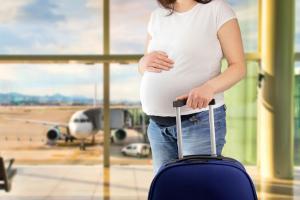If a woman is having a straightforward pregnancy, flying is not harmful to her or her baby. The safest time to fly is before 37 weeks as after this a woman could go into labour at any time

Obstetricians are commonly asked to give advice on whether it is suitable for women who are pregnant to fly during pregnancy. Such advice is sought because of the physiological and environmental changes associated with commercial air travel and also because of the possibility of preterm labour or an obstetric emergency developing while in flight.
ADVERTISEMENT
If a woman is having a straightforward pregnancy, flying is not harmful to her or her baby. The safest time to fly is before 37 weeks as after this a woman could go into labour at any time. However, for women carrying uncomplicated twins, the safest time to fly is before 32 weeks.
The main concern restricting the airlines from accepting pregnant women as passengers relates to the risk of labour developing, which may disrupt or divert the flight and the lack of appropriate care providers and facilities to manage labour or any obstetric complication in flight.
The key change in environment associated with commercial air travel is the cabin altitude. Although cabins are pressurised, this will equate to a cabin altitude of between 4000 and 8000 feet at cruising altitude. Thus, the barometric pressure is significantly lower than at sea level and there will be a concomitant reduction in the partial pressure of oxygen, in turn resulting in a reduction in blood oxygen saturation by around 10%. Such a reduction does not pose a problem for healthy individuals and this remains so in pregnancy.
Some pregnant women may experience discomfort during flying, for example, swelling of their legs, pregnancy sickness, nasal congestion and problems with their ears. With increasing altitude and reduction in barometric pressure, gases expand. This most frequently leads to problems within the ear, particularly if there is nasal congestion, which is more common because of the vasodilatation of pregnancy.
Long haul flights increase the risk of developing a Deep Vein Thrombosis (DVT), a blood clot that forms in your leg or pelvis due to sitting for a prolonged length of time. Pregnancy increases this risk further. We recommend that women wear loose clothing and comfortable shoes, take regular walks around the plane, do in-seat exercises every 30 minutes, have regular cups of water, cut down on drinks containing alcohol or caffeine and wear graduated elastic compression stockings.
There may be some circumstances when it may be advised not to fly, for example, if a woman has an increased risk of going into labour before their due date, has severe anaemia, sickle cell disease, has recently had significant vaginal bleeding or if a woman has a serious condition affecting her lungs or heart.
Body scanners that utilise ionising radiation for security checks do not pose a risk to mother or fetus from radiation exposure. Flights of more than 4-hour duration are associated with a small increase in the relative risk of venous thrombosis, but overall the absolute risk is very small.
Dr Aruna Kalra, Director and Senior Gynaecologist Surgeon, CK Birla Hospital says that a pregnant women should carry few important documents while on board such as, her pregnancy notes, documents confirming her due dates, and any medication she is taking.
Catch up on all the latest Crime, National, International and Hatke news here. Also download the new mid-day Android and iOS apps to get latest updates
 Subscribe today by clicking the link and stay updated with the latest news!" Click here!
Subscribe today by clicking the link and stay updated with the latest news!" Click here!






